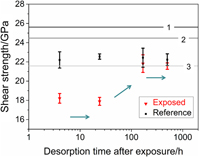Crossref Citations
This article has been cited by the following publications. This list is generated based on data provided by
Crossref.
Xiao, Xiazi
Terentyev, D.
Bakaev, A.
Zinovev, A.
Dubinko, A.
and
Zhurkin, E.E.
2019.
Crystal plasticity finite element method simulation for the nano-indentation of plasma-exposed tungsten.
Journal of Nuclear Materials,
Vol. 518,
Issue. ,
p.
334.
Fang, Xufei
Rasinski, Marcin
Kreter, Arkadi
Kirchlechner, Christoph
Linsmeier, Christian
Dehm, Gerhard
and
Brinckmann, Steffen
2019.
Plastic deformation of tungsten due to deuterium plasma exposure: Insights from micro-compression tests.
Scripta Materialia,
Vol. 162,
Issue. ,
p.
132.
Das, Suchandrima
2019.
Recent advances in characterising irradiation damage in tungsten for fusion power.
SN Applied Sciences,
Vol. 1,
Issue. 12,
Xiao, Xiazi
Terentyev, D.
Ruiz, A.
Zinovev, A.
Bakaev, A.
and
Zhurkin, E.E.
2019.
High temperature nano-indentation of tungsten: Modelling and experimental validation.
Materials Science and Engineering: A,
Vol. 743,
Issue. ,
p.
106.
Ebner, Anna Sophie
Brinckmann, Steffen
Plesiutschnig, Ernst
Clemens, Helmut
Pippan, Reinhard
and
Maier-Kiener, Verena
2020.
A Modified Electrochemical Nanoindentation Setup for Probing Hydrogen-Material Interaction Demonstrated on a Nickel-Based Alloy.
JOM,
Vol. 72,
Issue. 5,
p.
2020.
Terentyev, D.
Xiao, Xiazi
Lemeshko, S.
Hangen, Ude
and
Zhurkin, E.E.
2020.
High temperature nanoindentation of tungsten: Modelling and experimental validation.
International Journal of Refractory Metals and Hard Materials,
Vol. 89,
Issue. ,
p.
105222.
Fang, Xufei
Ding, Kuan
Janocha, Stephan
Minnert, Christian
Rheinheimer, Wolfgang
Frömling, Till
Durst, Karsten
Nakamura, Atsutomo
and
Rödel, Jürgen
2020.
Nanoscale to microscale reversal in room-temperature plasticity in SrTiO3 by tuning defect concentration.
Scripta Materialia,
Vol. 188,
Issue. ,
p.
228.
Rassinfosse, Louis
Colaux, Julien L.
Pilloud, David
Nominé, Alexandre
Tumanov, Nikolay
Lucas, Stéphane
Pireaux, Jean-Jacques
and
Haye, Emile
2020.
Using ammonia for reactive magnetron sputtering, a possible alternative to HiPIMS?.
Applied Surface Science,
Vol. 502,
Issue. ,
p.
144176.
Das, Suchandrima
Yu, Hongbing
Mizohata, Kenichiro
Tarleton, Edmund
and
Hofmann, Felix
2020.
Modified deformation behaviour of self-ion irradiated tungsten: A combined nano-indentation, HR-EBSD and crystal plasticity study.
International Journal of Plasticity,
Vol. 135,
Issue. ,
p.
102817.
Li, Y.
Morgan, T.W.
Terentyev, D.
Ryelandt, S.
Favache, A.
Wang, S.
Wirtz, M.
Hoefnagels, J.P.M.
van Dommelen, J.A.W.
De Temmerman, G.
Verbeken, K.
and
Geers, M.G.D.
2020.
Three mechanisms of hydrogen-induced dislocation pinning in tungsten.
Nuclear Fusion,
Vol. 60,
Issue. 8,
p.
086015.
Gago, M
Kreter, A
Unterberg, B
and
Wirtz, M
2021.
Synergistic and separate effects of plasma and transient heat loads on the microstructure and physical properties of ITER-grade tungsten.
Physica Scripta,
Vol. 96,
Issue. 12,
p.
124052.
Duarte, M. J.
Fang, X.
Rao, J.
Krieger, W.
Brinckmann, S.
and
Dehm, G.
2021.
In situ nanoindentation during electrochemical hydrogen charging: a comparison between front-side and a novel back-side charging approach.
Journal of Materials Science,
Vol. 56,
Issue. 14,
p.
8732.
George, Jeena
Mannepalli, Sowjanya
and
Mangalampalli, Kiran S. R. N.
2021.
Understanding Nanoscale Plasticity by Quantitative In Situ Conductive Nanoindentation.
Advanced Engineering Materials,
Vol. 23,
Issue. 9,
Fang, Xufei
Bishara, Hanna
Ding, Kuan
Tsybenko, Hanna
Porz, Lukas
Höfling, Marion
Bruder, Enrico
Li, Yingwei
Dehm, Gerhard
and
Durst, Karsten
2021.
Nanoindentation pop‐in in oxides at room temperature: Dislocation activation or crack formation?.
Journal of the American Ceramic Society,
Vol. 104,
Issue. 9,
p.
4728.
Maya, P.N.
Mukherjee, S.
Sharma, P.
Karki, V.
Singh, M.
Satyaprasad, A.
Kumar, R.
Vala, S.
Abhangi, M.
Kannan, S.
Pujari, P.K.
Raole, P.M.
and
Deshpande, S.P.
2021.
Studies on the near-surface trapping of deuterium in implantation experiments.
Nuclear Fusion,
Vol. 61,
Issue. 3,
p.
036007.
Yu, Qianran
Chatterjee, Sabyasachi
Roche, Kenneth J
Po, Giacomo
and
Marian, Jaime
2021.
Coupling crystal plasticity and stochastic cluster dynamics models of irradiation damage in tungsten.
Modelling and Simulation in Materials Science and Engineering,
Vol. 29,
Issue. 5,
p.
055021.
Fang, Xufei
Ding, Kuan
Minnert, Christian
Nakamura, Atsutomo
and
Durst, Karsten
2021.
Dislocation-based crack initiation and propagation in single-crystal SrTiO3.
Journal of Materials Science,
Vol. 56,
Issue. 9,
p.
5479.
Huang, Hao-Xuan
Li, Yu-Hao
Li, Zhong-Zhu
Hou, Peng-Wei
Ma, Fang-Fei
Ren, Qing-Yuan
Zhou, Hong-Bo
and
Lu, Guang-Hong
2022.
Role of hydrogen in stability and mobility of vacancy clusters in tungsten.
Tungsten,
Vol. 4,
Issue. 3,
p.
219.
Stich, Stephan
Ding, Kuan
Muhammad, Qaisar Khushi
Porz, Lukas
Minnert, Christian
Rheinheimer, Wolfgang
Durst, Karsten
Rödel, Jürgen
Frömling, Till
and
Fang, Xufei
2022.
Room‐temperature dislocation plasticity in SrTiO3 tuned by defect chemistry.
Journal of the American Ceramic Society,
Vol. 105,
Issue. 2,
p.
1318.
Cao, Hailin
and
Wang, Shuai
2022.
The effect of hydrogen on dislocation motion and cracking in tungsten foil.
Corrosion Science,
Vol. 207,
Issue. ,
p.
110547.
